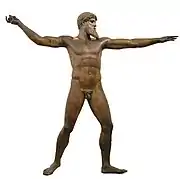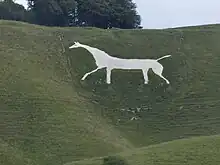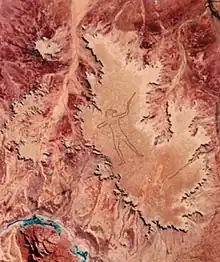
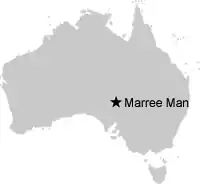
The Marree Man, or Stuart's Giant, is a modern geoglyph discovered in 1998. It appears to depict an Indigenous Australian man hunting with a boomerang or stick. It lies on a plateau at Finnis Springs 60 km (37 mi) west of the township of Marree in central South Australia, approximately 12 km north-west of Callanna. It is just outside the 127,000-square-kilometre (49,000 sq mi)[1] Woomera Prohibited Area. The figure is 2.7 km (1.7 mi) tall with a perimeter of 28 km (17 mi), extending over an area of about 2.5 km2 (620 acres). Although it is one of the largest geoglyphs in the world (arguably second to the Sajama Lines), its origin remains a mystery, with no one claiming responsibility for its creation nor any eye-witness having been found, notwithstanding the scale of the operation required to form the outline on the plateau floor. The description "Stuart's Giant" was used in anonymous faxes sent to media as "Press Releases" in July 1998, in a reference to the explorer John McDouall Stuart. It was discovered fortuitously by a charter pilot in an overflight on 26 June 1998.
Shortly after its discovery, the site was closed by the South Australian government following legal action taken in late July by native title claimants, but flights over the site were not forbidden as native title fell under federal government jurisdiction.
Work
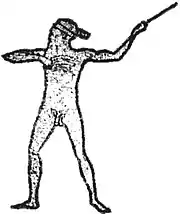
The Marree Man geoglyph depicts a man holding either a woomera (a throwing stick) or a boomerang (but see Plaque section below).
By December 1998, it had been noted that the outline matched, in reverse, that of the Artemision Zeus bronze raised from the bottom of the Adriatic Sea in 1928.[2]
The lines outlining the figure were 20–30 cm (7.9–11.8 in) deep at the time of discovery and up to 35 metres (115 feet) wide. The image was gradually eroded through natural processes, but because the climate is extremely dry and barren in the region, the image was still visible in 2013.[3] While there is a layer of white chalk material slightly below the red soil, the figure was not defined to this depth.
The creation of Marree Man occurred between 27 May and 12 June 1998. By comparing images collected on those dates from NASA's Landsat-5 satellite, the desert area where Marree Man was found goes from undisturbed to the completed figure. See image below:
Left image from 27 May 1998 Right image from 12 June 1998
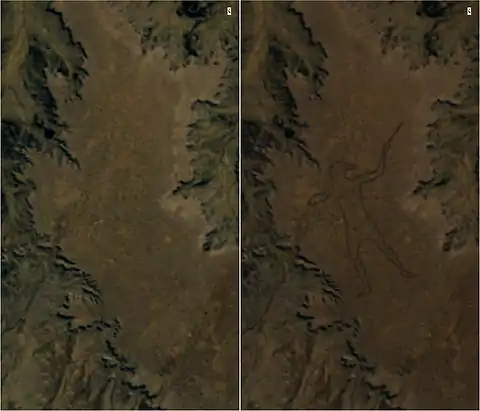
In August 2016, work was carried out to redefine the geoglyph using a grader assisted by GPS. The work resulted in an outline clearly visible from the air, matching the original.[4][5] Two decades after its creation it was speculated that the work itself could not have been created without GPS technology, then in its infancy.[6]
Discovery
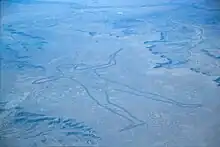
Trec Smith, a charter pilot flying between Marree and Coober Pedy in the remote north of South Australia, spotted the figure from the air on 26 June 1998.[7] The discovery of the geoglyph fascinated Australians due to its size and the mystery surrounding how it came to be there.
Shane Anderson from the William Creek Hotel, located 200 km (120 mi) north-west of the town of Marree, claimed the hotel received an anonymous fax describing the location of the artwork.[8]
Anonymous press releases
Several anonymous press releases sent to media and local businesses in July[9] and August 1998 led to the suggestion that the Marree Man was created by people from the United States. The releases said "your State of SA", "Queensland Barrier Reef" and mentioned Aborigines "from the local Indigenous Territories", terms not used by Australians. The press releases also mentioned the Great Serpent in Ohio, which is not well known outside the US. It was also conjectured that these features of the press releases may have been red herrings, inserted to provide an illusion of American authorship.[10]
Preservative bottle
On 16 July 1998, it was reported that a small glass jar had been found in a trough freshly dug at the site containing a satellite photo of the Marree Man together with a note bearing a U.S. flag and references to the Branch Davidians and "Stuart's Giant".[10][11]
Plaque
In January 1999, a fax sent to officials described a dedication plaque buried 5 metres (16 feet) south of the nose of the figure. The plaque bore an American flag, 3 cm (1.2 in) long by 2 cm (0.79 in) wide, with an imprint of the Olympic rings and bore the words,
In honour of the land they once knew. His attainments in these pursuits are extraordinary; a constant source of wonderment and admiration.[12]
which come from Hedley H. Finlayson's 1946 book The Red Centre, in a section describing the hunting of wallabies with throwing sticks and with photographs of hunters without loincloths and other details seen in the "Marree Man".[13] The book deals with hunters of the Pitjantjatjara tribe.[14]
Suggested creator
Bardius Goldberg, a Northern Territory artist who died in 2002 and lived at Alice Springs, has been suggested as the creator of the work. Goldberg, who was known to be interested in creating a work visible from space, refused when questioned to either confirm or deny that he had created the image.[15]
Others have suggested that members of either the Australian Army or American soldiers stationed in Woomera are responsible.[16][17]
Reactions
Much of the public and media reaction to the discovery of the figure was positive. The Advertiser, the state's only daily newspaper, called for the figure to be made permanent by excavating the outline down to the white chalk layer.
At the time of discovery, the area was part of a Federal Court lawsuit through the National Native Title Tribunal to determine the traditional owners. The area was claimed by both the Arabunna people and the Dieri Mitha who had been in dispute for several years.[18] The Dieri Mitha publicly complained of harm and exploitation of the Dreamtime, calling for the image to be erased and for the artist to be prosecuted. As native title claimants, the Dieri Mitha took legal action to stop charter flights and vehicles visiting the site, prompting the state government to close the area to the public shortly after discovery. The Arabunna replied, through a solicitor, that the area covered points of archaeological interest and that the artist could be prosecuted.[19] In May 2012, the Federal Court handed native title to the Arabunna people.[20]
The artwork was called environmental vandalism by the former Environment Minister, Dorothy Kotz, and graffiti by the South Australian chief of Aboriginal affairs, David Ruthman.[19]
In June 2018, adventurer Dick Smith revealed that he had had a team working on investigating the origins of Marree Man for two years to no avail and was offering a A$5,000 reward for information leading to identifying its creators.[21] The South Australian state government subsequently formally stated that they would not pursue any legal proceedings against the creators if identified.[22]
See also
References
- ↑ "WOOMERA PROHIBITED AREA" (PDF). Four Wheel Drive South Australia. 14 April 2002. Retrieved 5 November 2013.
- ↑ Jones, Philip (December 1998). "Zeus Stands Tall in the Desert". The Adelaide Review.
- ↑ "Push to spruce up mysterious desert artwork". Australian Broadcasting Corporation. Retrieved 27 May 2013.
- ↑ "Marree Man restored as outback tourist attraction". Australian Broadcasting Corporation. 20 August 2016. Retrieved 20 August 2016.
- ↑ "Giant Marree Man makes a comeback in South Australian outback". The Guardiandate=20 August 2016. Retrieved 21 August 2016.
- ↑ Mao, Francis (26 June 2018). "Marree Man: The enduring mystery of a giant outback figure". BBC. Retrieved 26 June 2018.
- ↑ "Marree Man". Lake Eyre Helicopters, Contract Helis. Archived from the original on 30 June 2016. Retrieved 30 May 2016.
- ↑ Elizabeth Henson (19 August 2016). "Return of the mysterious giant Marree Man geoglyph in the desert sands". The (Adelaide) Advertiser. Retrieved 26 August 2017.
- ↑ "Mystery surrounds huge image in outback SA". ABC News. 10 July 1998. Archived from the original on 26 April 2003.
- 1 2 Eccleston, Roy (5–6 September 1998). "The Mystery of Maree Man". The Weekend Australian. pp. 5–6.
- ↑ Hurrell, Bronwyn; Cock, Anna (16 July 1998). "Whoever did it, it's great for tourism". Adelaide Advertiser.
- ↑ "Trash City: News you may have missed". February 1999.
- ↑ "Marree Man - The Evidence". Archived from the original on 26 February 2006.
- ↑ "Marree Man - Australia 1998". Archived from the original on 7 February 2005.
- ↑ Corcoran, Dee (23 August 2002). "Marree man still a mystery". Northern Territory News. News Limited. Archived from the original on 17 December 2009. Retrieved 31 July 2009.
- ↑ "Marree Man: The enduring mystery of a giant outback figure". BBC News. 26 June 2018.
- ↑ "Who's the giant man in the outback? | Tour SA".
- ↑ In January 1995 the two groups had fought over the issue, leaving one dead and ten injured. In May 1998, only one month before the discovery of the geoglyph, the National Native Title Tribunal took the issue to the Federal Court. Although a resolution was expected to be reached quickly, the case was eventually to take 14 years before the Federal Court was able make a ruling: Dodd v State of South Australia [2012] FCA 519 (22 May 2012), Federal Court (Australia).
- 1 2 Leave our land alone Archived 17 April 2012 at the Wayback Machine The Advertiser 17 July 1998 State Library of South Australia
- ↑ Court ruling on Eyre handover The Australian 22 May 2012
- ↑ "Australian entrepreneur offers cash reward to solve geoglyph mystery". CNN. 25 June 2018. Retrieved 19 November 2018.
- ↑ Jones, Erin (12 October 2018). "Dick's Marree Man Plea". The Advertiser. p. 3.
External links
29°31′48″S 137°27′56″E / 29.53°S 137.4655°E
- View in Google Maps: "Google Maps". Google Maps. Retrieved 19 September 2010.
- Audio Interviews with Brad Thompson, Marree-based pilot: Centenary of Federation - Connecting the Continent
- UFO Updates: Skywatch: New Clues To Marree Man Mystery at the Wayback Machine (archived 15 September 2007)
